LHS 1140 is a red dwarf located 48.80 light-years away in the constellation Cetus. With an apparent magnitude of 14.18, it is invisible to the unaided eye. The star hosts two extrasolar planets, LHS 1140 b and LHS 1140 c, discovered in 2017 and 2018. The exoplanet LHS 1140 b orbits in the parent star’s habitable zone. The temperate planet is one of the nearest potentially habitable exoplanets to the Sun.
Star type
LHS 1140 is a red dwarf star of the spectral type M4.5V. It has a mass of only 0.1844 solar masses and a radius of 0.2159 solar radii. With a surface temperature of 3,096 K, it shines with 0.0038 solar luminosities. The low-mass star has a rotation period of around 131 days. It has an estimated age of at least 5 billion years.
In 2025, a team of scientists led by Aedan DiSanto, Villanova University, Pennsylvania, determined an age of around 8 ± 1.7 Gyr for LHS 1140 using stellar kinematics, gyrochronology, coronal X-ray emissions as seen by XMM Newton and Swift, and age-metallicity relationships (AMRs).
Unlike many other nearby red dwarfs, including Proxima Centauri, Barnard’s Star and Wolf 359, LHS 1140 has not been observed to show flares. The inactivity of the planetary system’s host star means that the orbiting planets should be able to retain any potential atmosphere over long periods of time. This makes LHS 1140 b one of the nearest currently known temperate exoplanets to Earth and an exceptional candidate for future habitability studies.
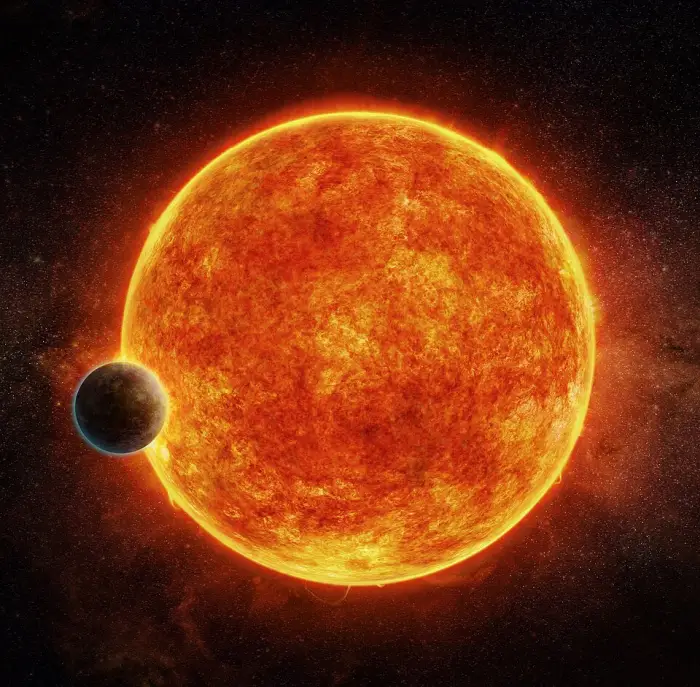
Illustration of LHS 1140 and the planet LHS 1140 b. Image credit: M. Weiss/CfA (CC BY 4.0)
Planets
LHS 1140 has two confirmed planets orbiting it. LHS 1140 b, the outer planet, was discovered in 2017, and LHS 1140 c in 2018.
The inner planet, LHS 1140 c is a rocky planet that orbits too close to its host star to harbour liquid water on its surface. LHS 1140 b, on the other hand, is believed to be a potentially habitable water world. It is listed as a potentially habitable exoplanet in the NASA Exoplanet Archive and in the Habitable Worlds Catalog (HWC).
A third candidate planet, LHS 1140 d, was initially reported in 2018 and its orbital elements refined in 2020, but a 2024 study by Charles Cadieux et al. found no evidence for it. The researchers attributed the 78.9-day signal to stellar activity.
The 78.9-day orbital period was reported by a team led by J. Lillo-Box of the Centro de Astrobiología (CAB, CSIC-INTA), Departamento de Astrofísica, Madrid, Spain, using NASA’s Transiting Exoplanet Survey Satellite (TESS) and the Echelle SPectrograph for Rocky Exoplanets and Stable Spectroscopic Observations (ESPRESSO) instrument on ESO’s Very Large Telescope on Cerro Paranal in northern Chile. The observations indicated the presence of a candidate rocky planet with a minimum mass of 4.8 Earth masses orbiting LHS 1140 beyond the habitable zone. The study was published in the journal Astronomy & Astrophysics in October 2020.
In 2024, a team of astronomers led by Charles Cadieux of the Trottier Institute for Research on Exoplanets (IREx), Université de Montréal, Canada, placed new mass and radius constraints on the two confirmed planets orbiting LHS 1140 based on observations with the VLT/ESPRESSO. The astronomers analysed data obtained with the ESPRESSO instrument, as well as by the Hubble Space Telescope (HST), the infrared Spitzer Space Telescope, and the Transiting Exoplanet Survey Satellite (TESS).
The team found LHS 1140 b to be either a water world or a temperate mini-Neptune, noting that it was unlikely to be a rocky super-Earth. They constrained the planet’s radius to 1.730 ± 0.025 Earth radii and determined a radius of 1.272 ± 0.026 for LHS 1140 c. The study was published in The Astrophysical Journal Letters, Vol. 970, Number 1.
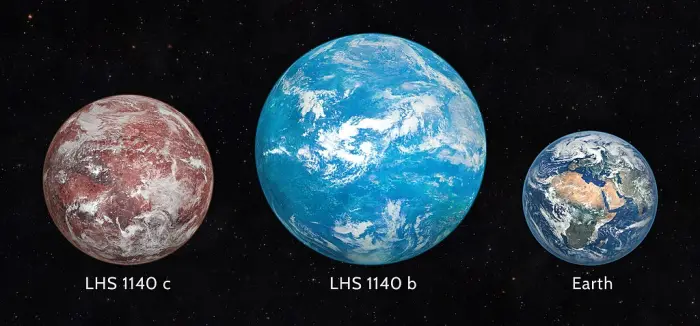
Size comparison of the two known planets of LHS 1140 (artistic concept) with Earth. Credit: Martin Vargic / Halcyon Maps (CC BY 3.0)
LHS 1140 b
LHS 1140 b has a mass of 5.60 ± 0.19 Earth masses and is 1.730 ± 0.025 times the size of Earth. It orbits LHS 1140 with a period of 24.73723 ± 0.00002 days at a distance of 0.0946 ± 0.0017 astronomical units. The planet orbits within the star’s conservative habitable zone and has a circular orbit, with an eccentricity of less than 0.29.
Even though it orbits the dwarf host at only 9.46% of the distance between the Earth and the Sun, LHS 1140 b gets only 43 percent of the incident flux that the Earth gets from the Sun. If the planet has an albedo (fraction of reflected starlight) similar to Earth’s, its equilibrium temperature would be 201 K (-72° C, -98° F). With an albedo of 0, it would be 230 k (-43° C, -46° F).
With a greenhouse effect as strong as Earth’s and an albedo of 0, the planet’s surface temperature would be over 266 K (-7° C, 19° F). Because of the planet’s high mass, astronomers believe that LHS 1140 b has a thicker atmosphere and a stronger greenhouse effect than our planet. With twice the greenhouse effect of Earth, the planet would have a surface temperature of 296 K (23° C, 73° F). If the planet’s atmosphere contains greenhouse gases, this would make the surface temperature higher, increasing the possibility of liquid water on the planet’s surface.
LHS 1140 b was discovered by the MEarth Project in 2017. The MEarth Project uses a robotic exoplanet observatory at the Fred Lawrence Whipple Observatory on Mount Hopkins in Arizona, to monitor red dwarfs and detect transiting planets. The planet’s presence was confirmed and its mass measured by the High Accuracy Radial Velocity Planet Searcher (HARPS) on ESO’s 2.6m telescope at La Silla Observatory in Chile.
Initially believed to be a dense rocky planet, LHS 1140 b was later found to have a larger diameter and lower density. With a density of around 7.82 g/cm3, it was still believed to have a rocky composition. A 2020 study proposed that water accounts for only 4% of the planet’s mass and that LHS 1140 b could be an ocean world with an average ocean depth of 779 ± 650 km.
However, the planet was later estimated to have between 9 and 19 percent of mass composed of water, which is consistent with a liquid water ocean world or a mini-Neptune.
In 2020, observations with the Wide Field Camera 3 (WFC3) on board the Hubble Space Telescope (HST) showed tentative evidence of water vapour in the planet’s atmosphere. However, further observations were required for confirmation of the findings.
More recently, observations with the James Webb Space Telescope (JWST) ruled out a hydrogen-rich atmosphere. In 2024, a team of astronomers led by Mario Damiano, Jet Propulsion Laboratory, California Institute of Technology (Caltech), obtained the transmission spectrum of LHS 1140 using Webb’s NIRSpec instrument. The researchers found that the spectrum was not consistent with an H2-rich atmosphere. The findings indicate that the planet’s low density can be explained if the planet is a water world with an atmosphere dominated by diatomic nitrogen (N2) and containing water (H2O) and carbon dioxide (CO2).
The scientists concluded that the planet in all likelihood has a high-pressure ice mantle, which may be mixed with a rocky mantle underneath, and that it may be a habitable water world, partly covered in liquid water. LHS 1140 b may be an eyeball planet, a planet that is tidally locked to its parent star (with the same side always facing the star), on which the presence of liquid water is confined to a ring-shaped area on the planet’s surface. It may also be a snowball planet, an ice-rich exoplanet with a thin ice shell and a subsurface ocean.
A different 2024 study, led by Charles Cadieux, reported the presence of a nitrogen-rich atmosphere based on observations with the NIRISS instrument on the James Webb Space Telescope. The astronomers concluded that LHS 1140 b was most likely a water world, with or without a secondary atmosphere.
The observations provided astronomers with the first hint of an atmosphere on a rocky or ice planet orbiting in the goldilocks zone of its parent star. This, combined with the less active host star, makes LHS 1140 b a more interesting target for studies of potentially habitable worlds than the more widely publicized TRAPPIST-1 planets.
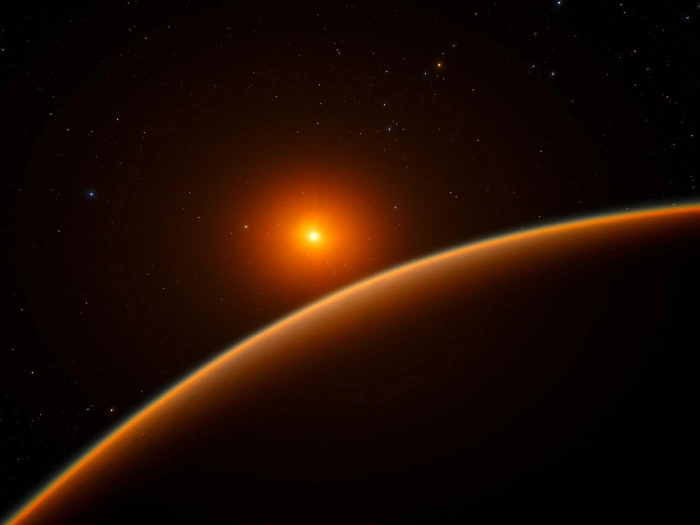
This artist’s impression shows the exoplanet LHS 1140b, which orbits a red dwarf star 40 light-years from Earth and may be the new holder of the title “best place to look for signs of life beyond the Solar System”. Using ESO’s HARPS instrument at La Silla, and other telescopes around the world, an international team of astronomers discovered this super-Earth orbiting in the habitable zone around the faint star LHS 1140. This world is a little larger and much more massive than the Earth and has likely retained most of its atmosphere. Credit: ESO/spaceengine.org (CC BY 4.0)
LHS 1140 c
LHS 1140 c, the inner planet in the LHS 1140 system, has a mass 1.91 ± 0.06 times that of the Earth and a radius 1.272 ± 0.026 times the Earth’s. This gives the small planet a density of around 5 g/cm3, indicating a rocky composition.
The planet orbits the host star with a period of 3.777940 ± 0.000002 days at a separation of 0.0270 ± 0.0005 AU. It has a dayside temperature of 561 ± 44 K, which indicates a planet without an atmosphere and with a low albedo. The planet may be similar to TRAPPIST-1b in the TRAPPIST-1 system.
LHS 1140 c was discovered using the transit method in 2018. The planet’s existence was first proposed by a team led by F. Feng, Centre for Astrophysics Research, University of Hertfordshire, UK, in 2018. The team reported the detection of a rocky planet with an orbital period of 24.7 days.
The planet was confirmed by a team led by Kristo Ment, Harvard-Smithsonian Center for Astrophysics, Cambridge, MA, based on photometric observations by MEarth and the Spitzer Space Telescope, as well as on Doppler spectroscopy with the HARPS instrument. The study was published in The Astronomical Journal in 2019.
The team reported a planet with a mass of 1.81 ± 0.39 Earth masses and a radius of 1.282 ± 0.024 Earth radii in close orbit with a period of 3.77795 days. The astronomers also provided more precise estimates for the parameters of LHS 1140 b: a mass of 6.98 ± 0.89 M⊕ and a radius of 1.727 ± 0.032 R⊕.
Name
LHS 1140 does not have a proper name formally approved by the International Astronomical Union (IAU). The designation LHS 1140 comes from the Luyten Half-Second catalogue, a catalogue of stars with proper motion of more than 0.5 arcseconds per year.
The star is catalogued as Gliese 3053 (GJ 3053) in the Gliese Catalogue of Nearby Stars and CNS5 217 in the Fifth Catalogue of Nearby Stars.
Location
LHS 1140 lies near Diphda (Beta Ceti), in the region of the Sea Monster’s tail. Diphda, the brightest star in Cetus, appears east of the imaginary line extended from Alpheratz through Algenib in the Great Square of Pegasus. LHS 1140 appears north of Diphda. With an apparent magnitude of 14.18, it can be spotted in an 8-inch telescope in good conditions.
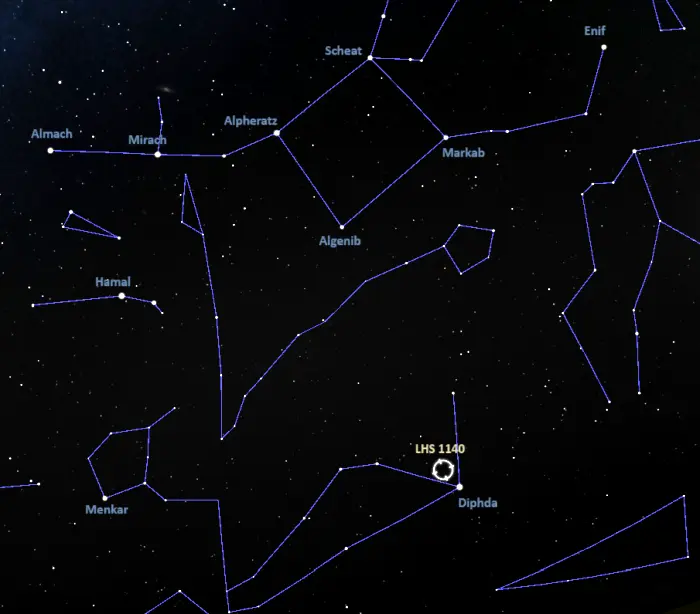
Location of LHS 1140, image: Stellarium
Constellation
LHS 1140 is located in the constellation Cetus. The celestial Sea Monster (or Whale) is one of the Greek constellations, catalogued by Claudius Ptolemy of Alexandria in the 2nd century CE. In Greek mythology, it is associated with the sea monster Cetus, defeated by Perseus as he saved the chained princess Andromeda from being sacrificed to appease the god Poseidon.
Cetus lies on the celestial equator and is visible from virtually anywhere for at least part of the year. It is the fourth largest of the 88 constellations, stretching across 1,231 square degrees of the predominantly southern sky. Despite its size, the Whale does not stand out in the sky. It contains only two stars brighter than magnitude 3.0.
Diphda (Beta Ceti), the constellation’s lucida, is an orange giant that shines at magnitude 2.02 from a distance of 96.3 light-years. It appears in the Sea Monster’s tail. Menkar (Alpha Ceti), the second brightest star in Cetus, appears in the Sea Monster’s head. The red giant star has an apparent magnitude of 2.53 and lies approximately 249 light-years away.
Other notable stars in Cetus include the variable red giant Mira (Omicron Ceti), the nearby Sun-like star Tau Ceti and binary red dwarf system Luyten 726-8 (BL Ceti and UV Ceti), the binary star Baten Kaitos (Zeta Ceti), the orange giants Eta Ceti, Iota Ceti and Theta Ceti, the triple star system Gamma Ceti (Kaffaljidhma), and Earendel (WHL0137-LS), the most distant star known.
Deep sky objects in Cetus include the spiral galaxies Messier 77 (Cetus A, the Squid Galaxy), the Claw Galaxy (NGC 247), NGC 1035, NGC 1042, NGC 1055, the irregular galaxy IC 1613, and the planetary nebula NGC 246, popularly known as the Skull Nebula.
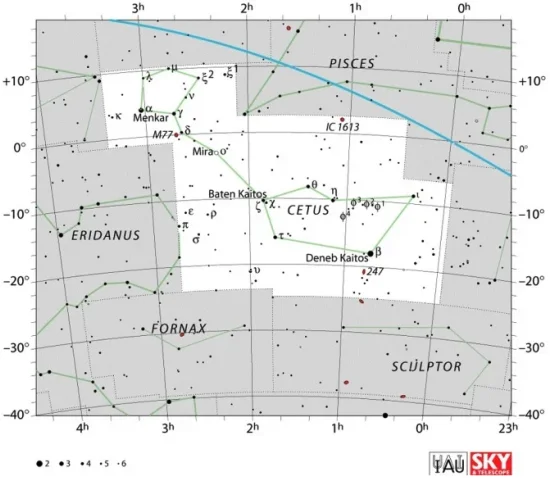
Cetus constellation map by IAU and Sky&Telescope magazine (Roger Sinnott & Rick Fienberg) (CC BY 3.0)
The best time of the year to see the stars and deep sky objects in Cetus is during the month of November, when the constellation climbs higher above the horizon in the evening. The entire constellation can be seen from locations between the latitudes 70° N and 90° S.
The 10 brightest stars in Cetus are Diphda (Beta Ceti, mag. 2.02), Menkar (Alpha Ceti, mag. 2.53), Eta Ceti (mag. 3.446), Kaffaljidhma (Gamma Ceti, mag. 3.47), Tau Ceti (mag. 3.50), Iota Ceti (mag. 3.562), Theta Ceti (mag. 3.60), Baten Kaitos (Zeta Ceti, mag. 3.742), Upsilon Ceti (mag. 3.95), and Delta Ceti (mag. 4.06). The pulsating variable star Mira (Omicron Ceti, mag. 2.0 – 10.1) is sometimes among the brightest stars in the constellation and at other times it is invisible to the naked eye.
LHS 1140
| Spectral class | M4.5V |
| Apparent magnitude | 14.18 |
| Distance | 48.80 ± 0.03 light-years (14.96 ± 0.01 parsecs) |
| Parallax | 66.8287 ± 0.0479 mas |
| Radial velocity | −13.74 ± 0.42 km/s |
| Proper motion | RA: 318.152 ± 0.049 mas/yr |
| Dec.: -596.623 ± 0.054 mas/yr | |
| Mass | 0.1844 ± 0.0045 M☉ |
| Luminosity | 0.0038 ± 0.0003 L☉ |
| Radius | 0.2159 ± 0.0030 R☉ |
| Temperature | 3,096 ± 48 K |
| Metallicity | −0.15 ± 0.09 dex |
| Age | > 5 billion years |
| Rotation | 131 ± 5 days |
| Surface gravity | 5.041 ± 0.016 cgs |
| Constellation | Cetus |
| Right ascension | 00h 44m 59.3309137511s |
| Declination | −15° 16′ 17.542839990″ |
| Names and designations | LHS 1140, GJ 3053, NLTT 2465, CNS5 217, TOI-256, G 270-58, G 268-38, TIC 92226327, PM J00449-1516, UCAC4 374-000830, WISEA J004459.56-151623.9, WT 1138, 2MASS J00445930-1516166, Gaia DR2 2371032916186181760, Gaia DR3 2371032916186181760 |